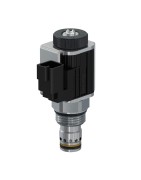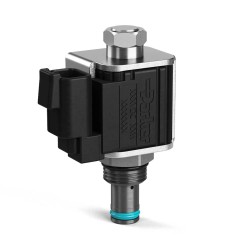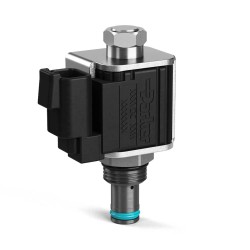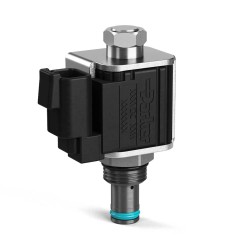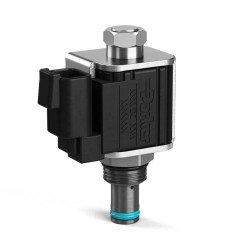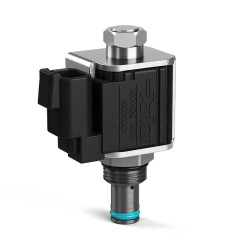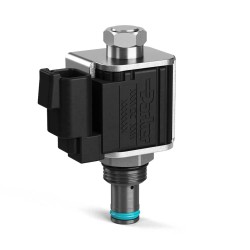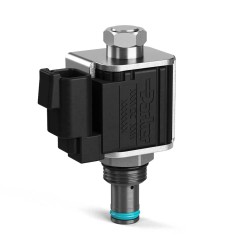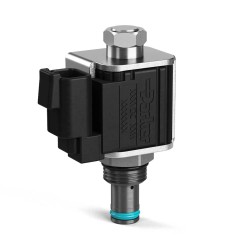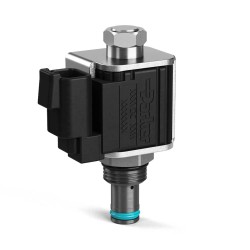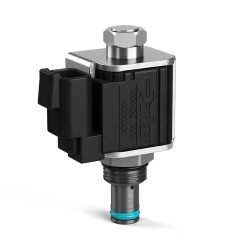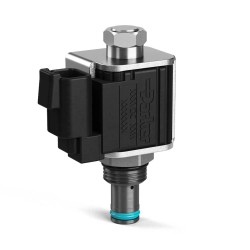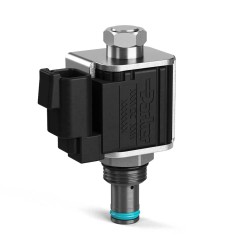Pressure Relieving Proportional Valve
Parker offers direct and pilot operated proportional relief valves. Two styles are available; increasing pressure with increasing current, and decreasing pressure with increasing current. All styles offered normally opened or normally closed.
Normally Closed Proportional Relief Valve
Normally closed proportional relief valves are used to electronically control the system pressure. These valves are ideal for circuits with varying system pressures demands. A small flow pilot version of the normally closed proportional relief is also offered for piloting a larger logic element or vented relief valve. The normally closed relief defaults to a maximum pressure setting (i.e. 3000 psi) when there is no current applied.
OPERATION - With the solenoid coil de-energized, the pilot dart is held closed by the spring. As current is applied to the coil, the pilot dart is moved creating less restriction of the pilot flow. As this restriction is reduced with the increasing current, the pressure setting also decreases. Once a constant electronic signal is given, the pilot dart is held in a given position, holding the pressure setting. This is maintained by the balance between the electronic spring force and the inlet pressure.
Normally Open Proportional Relief Valve
Normally open proportional relief valves are used to electronically control the system pressure. These valves are ideal for circuits with varying system pressure demands. A small flow pilot version of the normally open proportional relief is also offered for piloting a larger logic element or vented relief valve. The normally open relief defaults to minimum system pressure (i.e. 150 psi) when there is no current applied. Normally closed versions are also available upon request.
OPERATION - With the solenoid coil de-energized, the pilot dart is held open by the spring. This allows the main spool to open at minimum pressure 10.4 Bar (150 psi). As current is applied to the coil, the pilot dart is moved towards the pilot seat restricting pilot flow. This restriction raises the effective pressure setting of the valve. Once a constant electronic signal is given, the pilot dart is held in a given position, holding the pressure setting. This is maintained by a balance between electronic spring force and inlet pressure. As the electronic signal is reduced, the pilot dart is moved away from the pilot seat. This lowers the effective pressure setting of the valve.
Parker’s normally open series of Proportional Relief Valves include the following product families:
Series Flow Pressure Ranges
AP02B2YP .35 gpm-1.4 gpm 1000 psi – 5000 psi
AP04G2YP 25 gpm 1500 psi – 5000 psi
Parker’s normally closed series of Proportional Relief Valves include the following product families:
Series Flow Pressure Ranges
AP02B2YR 0.5 gpm-1.4 gpm 1000 psi – 5000 psi
AP04G2YR 25 gpm 1500 psi – 5000 psi
Proportional relief valves are used in conjunction with larger valves to achieve high flow, proportional pressure control, or with the AP04G2YP can be used as a stand-alone pressure control valve.
Commonly found markets include, but are not limited to mobile construction equipment, aerial devices, industrial specialty machinery, and hydraulic power units.
Normally Closed Proportional Relief Valve
Normally closed proportional relief valves are used to electronically control the system pressure. These valves are ideal for circuits with varying system pressures demands. A small flow pilot version of the normally closed proportional relief is also offered for piloting a larger logic element or vented relief valve. The normally closed relief defaults to a maximum pressure setting (i.e. 3000 psi) when there is no current applied.
OPERATION - With the solenoid coil de-energized, the pilot dart is held closed by the spring. As current is applied to the coil, the pilot dart is moved creating less restriction of the pilot flow. As this restriction is reduced with the increasing current, the pressure setting also decreases. Once a constant electronic signal is given, the pilot dart is held in a given position, holding the pressure setting. This is maintained by the balance between the electronic spring force and the inlet pressure.
Normally Open Proportional Relief Valve
Normally open proportional relief valves are used to electronically control the system pressure. These valves are ideal for circuits with varying system pressure demands. A small flow pilot version of the normally open proportional relief is also offered for piloting a larger logic element or vented relief valve. The normally open relief defaults to minimum system pressure (i.e. 150 psi) when there is no current applied. Normally closed versions are also available upon request.
OPERATION - With the solenoid coil de-energized, the pilot dart is held open by the spring. This allows the main spool to open at minimum pressure 10.4 Bar (150 psi). As current is applied to the coil, the pilot dart is moved towards the pilot seat restricting pilot flow. This restriction raises the effective pressure setting of the valve. Once a constant electronic signal is given, the pilot dart is held in a given position, holding the pressure setting. This is maintained by a balance between electronic spring force and inlet pressure. As the electronic signal is reduced, the pilot dart is moved away from the pilot seat. This lowers the effective pressure setting of the valve.
Parker’s normally open series of Proportional Relief Valves include the following product families:
Series Flow Pressure Ranges
AP02B2YP .35 gpm-1.4 gpm 1000 psi – 5000 psi
AP04G2YP 25 gpm 1500 psi – 5000 psi
Parker’s normally closed series of Proportional Relief Valves include the following product families:
Series Flow Pressure Ranges
AP02B2YR 0.5 gpm-1.4 gpm 1000 psi – 5000 psi
AP04G2YR 25 gpm 1500 psi – 5000 psi
Proportional relief valves are used in conjunction with larger valves to achieve high flow, proportional pressure control, or with the AP04G2YP can be used as a stand-alone pressure control valve.
Commonly found markets include, but are not limited to mobile construction equipment, aerial devices, industrial specialty machinery, and hydraulic power units.
